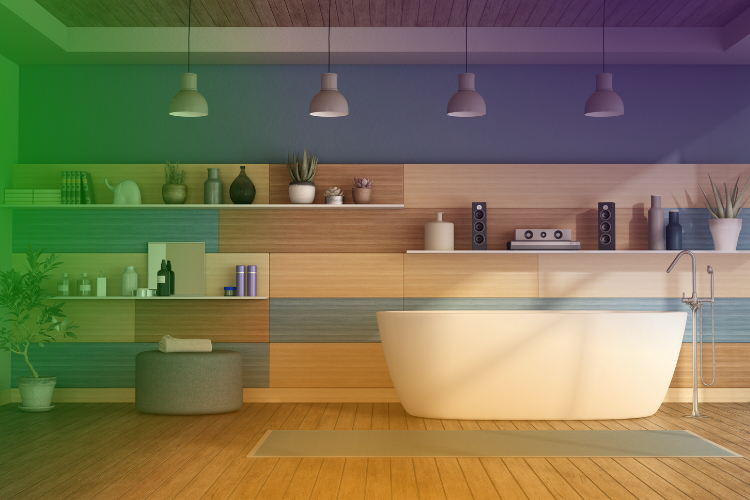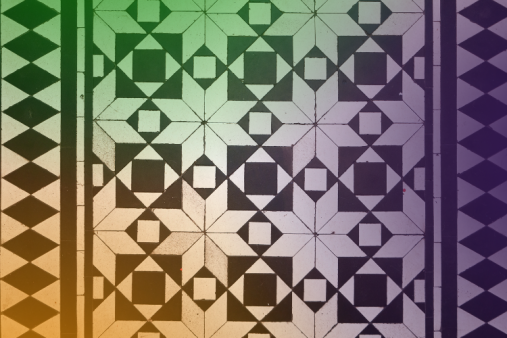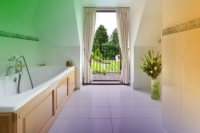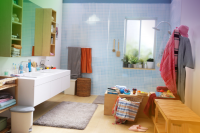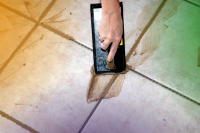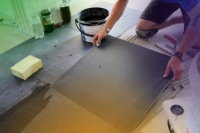What alternatives to tiles are there for the bathroom?
Most UK homes have tiles in the bathroom, and they are a practical and efficient way of keeping the water away from your walls. Tiles have been around in bathroom design for centuries and have their advantages: they are easy to clean, waterproof and come in an endless range of patterns and colours. But they’re not without their disadvantages too, as anyone who has spent a day scraping out old grout will know. Over time tile can crack or the grout can get dirty, and replacing tiles is a fairly major job. Although tiles might be the obvious choice for your bathroom renovation project, there are several other options which might be worth considering, both in terms of design merit and practicality. In recent years there have been many developments with new products on the market which provide a great bathroom alternative to tiles, and are not necessarily and more expensive.
Shower wall panels
Shower wall panels come in large sheets which are then cut to size and can be used in any areas of the bathroom which would otherwise be tiled. They are completely waterproof and very easy to fit; they are simply glued onto the wall and then finished with beading around the edges.
Shower wall panels come in all sorts of finishes, with some designed to look like tiles and others with a high-gloss contemporary look.
Expect to pay around £200 for enough shower panels to use in an average shower room, but as fitting costs are considerably less, you won’t be paying the £25 to £40 per square metre charges of the average tiler.
Wallboard as a Tile Alternative
Wallboard or wall panels are probably the most popular alternative to tiles. As the name suggests, these boards come in large sheets, with a fully waterproof surface. They can be used in a shower enclosure, as a backsplash, or anywhere you would conventionally use tiles.
One of the major advantages of wallboard is that it is quicker and easier to install. Wallboard can be cut to shape to cover large areas, and all you need to join sections of wallboard together in a corner or to cover a wide area are strips, usually made of metal, which seal the sections together. Panels don’t need to be grouted, and come in a huge range of finishes – you can even choose a finish which looks like tiles if you want the more traditional look. Prices for a single wall panel, usually measuring 2400mm by 1000mm and enough to cover one side of a shower cabinet, start at around £90. Some of the big brands on the market to look out for are Showerwall, Multipanel and Mere Reef. Rather than shopping online, take a trip to your local showroom where you can see lots of panels from a range of manufacturers all in the same place.
Glass Panels and Splashbacks
Glass splashbacks are a popular choice as a way of injecting a bit of colour into your kitchen, so why not use the same technique in the bathroom? Glass is by nature waterproof, and local glazibng firms can easily make sheets of glass to the perfect shape and size for the area you need to cover. Colour can be easily incorporated into glass panels, and can be colour matched to any item of your choosing; why not match your panel with a favourite blind, towels or other bathroom accessories? Most large towns and cities will have a glass company which can produce bespoke glass panels for your bathroom project, and as the glass they use is safety glass and designed for durability, there should be no concerns over safety either. Glass is tough, resistant and easy to keep clean too.
High gloss, glass bathroom panels are a modern and sleek choice and can be used in the kitchen as a splashback as well as in the bathroom. Glass sheets can be cut to exactly the right size for your room which means no joins in the middle of the wall, and can be made in any colour you choose. Glass is durable and hardwearing as well as completely waterproof. Glass panels are expensive though at around £200 for enough for a splashback above a vanity unit. They need different fitting skills to tiles too.
If you don’t want to use glass as a panel in the shower or above the bath, then you can easily mix and match it with tiles, using it just above the sink, for example. A smaller area may give the opportunity to go a bit bigger and bolder with pattern, colour or finish, which may be too much when used in a larger space.
Paint instead of Tiles?
Sometimes the low-tech options are the best, and paint is certainly worth considering when you’re renovating your bathroom. 20 years ago the fashion was for floor to ceiling tiling in a bathroom, but design tastes have moved on, and as long as the “wet” areas around the sink and shower are protected, then there’s no need to have the expense of tiling across the full height of the room.
There are a couple of considerations if you’re thinking about painting areas of your bathroom though. Firstly, if the area has previously been tiled, removing the tiles is unlikely to give a perfectly smooth surface to paint on top of, so you might incur extra costs for plastering first. Secondly, think about the sort of paint you choose for use in a bathroom. Special kitchen and bathroom paint might be a bit more expensive, but is designed to be water resistant. Ordinary emulsion paint might look fine to start with, but as people have baths or showers, the steam and humid atmosphere will over time cause the paint to flake.
Wallpaper in Bathrooms
Wallpaper in bathrooms has been around since Victorian times, and is also proving popular in the 21st century. Just as with paint, the key is preparing the surface of the wall so that it is smooth, and choosing a suitable paper for the job. Vinyl coated paper is the obvious choice, but can be quite glossy and shiny. Any foil finish paper will be suitable, as will any paper marketed specifically for bathroom use. Prolong the life of your bathroom wallpaper by getting into the habit of always opening a window or leaving the door open after you’ve showered to stop condensation building up on the surfaces which you have papered. If you’re struggling to work out how paper might look in your own bathroom look online for inspiration, there are thousands of pictures of wallpaper being used in bathrooms of all shapes and sizes.
Stainless Steel in the Bathroom
Stainless steel surfaces have been rapidly gaining popularity in kitchens, taking their cue from high-traffic commercial workspaces. The appearance of stainless steel isn’t for everyone; It gives a very clinical appearance which might work best in an ultra-modern bathroom. On the other hand, stainless steel is chosen for commercial kitchen and medical settings because it is so robust and hard-wearing, resisting staining and cracks. An entire wall clad in stainless steel might be a bit much for most homes, but a steel panel around a shower, or used in a smaller quantity above the sink as a splashback can be really effective. Although most of the bathroom supply wall panels which look like stainless steel, you might have to go to a commercial supplier for the real thing.
Marble Walls and Splashbacks in the Bathroom?
Nothing screams luxury quite like marble, and the material has been used in bathrooms for centuries. As a natural material, the beauty of marble is that every sheet is different, and the grain and seams through the marble creates a unique look. Marble can be pricey though, especially when you are covering a large area. Marble can be tricky to clean too, as it can be damaged by many of the commercial bathroom cleaning products. A good compromise might be looking for one of the wallboard products which have the surface appearance of marble, but none of the drawbacks of using the real thing. These products vary hugely in appearance and quality though, so always make time to go into a showroom and choose your products rather than just looking online.
Rubber Flooring for Bathrooms
When it comes to your bathroom floors, tiles are certainly practical but can be cold and unwelcoming when you step on them on a cold winter morning. One of the most practical alternatives is rubber. This sort of flooring is non-slip, feels warm underneath and comes in a massive colour range. It is also very hard-wearing and although it can be more expensive than tiling initially at around £40 per square metre. It is as easy to install as a vinyl floor and will last as long as 20 years before it starts looking scruffy.
Wooden Bathroom Walls
In the days before tiles were commonplace in the UK, we used wooden panelling to make things waterproof. The trend for incorporating natural materials into the bathroom isn’t going away any time soon, and pine panelling may reek of the 1970s or Swedish saunas, but is wood a good choice to use as panels in the bathroom? The downside of wood is that it can absorb water and swell, so isn’t suitable for using on panels in shower enclosures or as a splashback above a sink. Elsewhere in the bathroom though, wood can easily be used as floor or wall coverings, as long as the room is properly ventilated and water is not allowed to pool on the surfaces. Given the popularity of wood, many tile and wallboard manufacturers make products with the appearance of wood, but which are fully water-resistant. If you do opt for wooden wall covering in the bathroom, paint the wood panelling white, cream or pale blue and it looks completely different and has the look and feel of a cottage. Using pine tongue-and-groove panelling also can hide a multitude of sins and uneven plastering. If you use a silk or satinwood paint your wood panelling will be waterproof and can be wiped down if it gets marked. Wood is also a good choice for using on the bathroom floor. However, make sure that if you are using natural wood it is properly sealed with the correct type of varnish, or that you use a laminate flooring which is specifically designed for bathrooms.
Fitting your Chosen Bathroom Wall Covering
The other issue to look at – whatever alternative to tiles you choose for your bathroom – is how you are going to fit it. Some products, such as wall boards, are relatively straightforward and are easy to cut and shape to size. Other products, such as marble or glass, are harder to manipulate and will require fitting by someone who knows what they are doing. If you choose a very unusual way of covering your bathroom walls then you might have to search for a skilled installer nearby, and if skills are in high demand, prices will rise accordingly. Often the best method of choosing is to go direct to manufacturers or showrooms where you can compare a range of options, and weigh up the benefits and drawbacks of each. Showrooms will usually also have their own team of installers who have experience with the products, and will quote you for both supplying the product, and fitting it into your home. Always take care to compare prices from more than one supplier, and this is especially the case if you are buying products yourself online and then arranging installation separately. The cheapest quote you receive isn’t always the best; look at other factors too such as how quickly the contractor can get the job done, and how much experience they have in projects of a similar nature.
Undecided?
If you’re still confused about the range of wall options for your bathroom don’t rush into any decisions. Look online, request brochures or make an appointment at your local bathroom showroom to see some of the products. Narrow down your options, taking advice on overall cost as well as the style and design advantages.
